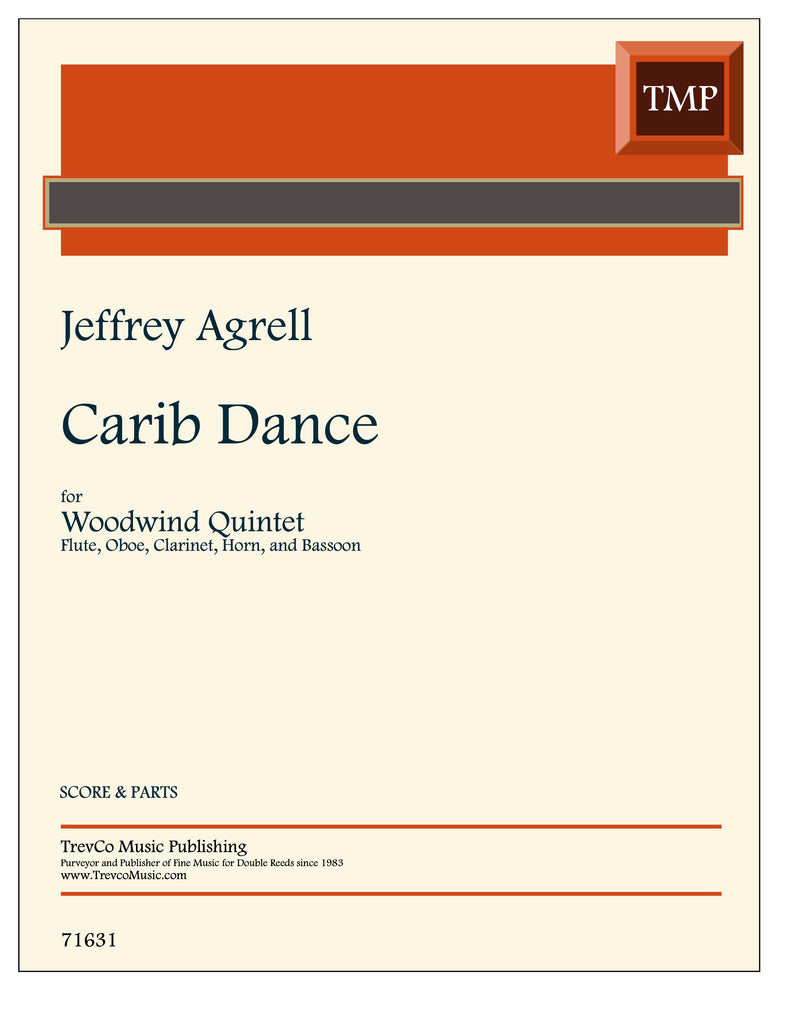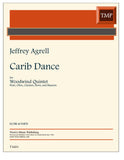Carib Dance - WW5
Composer: Agrell, Jeffrey
Publisher: TrevCo
Edition: 71631
$35.00
Carib Dance
for woodwind quintet: flute, oboe, clarinet, horn, and bassoon
by Jeffrey Agrell - American composer and hornist
About the Music
Carib Dance was written for the Wildwind Quintet, which specialized in uncommon repertoire and performance practice. One unusual thing about this piece is that it works well as an audience participation number, so if you have a family concert, this is ideal for that. You can omit the audience participation part if you like for more formal evening concerts (although you could do it anyway…).
Audience participation version: consider programming it last in a concert. You begin by giving the audience a phony introduction to the piece, saying that this is a work for woodwind quintet plus fifty singers and fifty percussionists (make up your own numbers), because this is Latin American style music and it requires the voices and percussion to give it the proper setting, mood, blah blah. Look at your watch with some alarm and say, “The bus with the musicians is a bit overdue and will be arriving momentarily, and as soon as they crowd up on stage here with us we can play the piece.”
So one of you jumps off stage and runs out the back or back of the hall to check on the bus. Some talking is heard in the hall outside or offstage (or you could do this on stage if you can arrange to be called on your cell phone). And then you come back in a minute with a long face, and the others say, “Well?” and you say, I just found out that bus driver misunderstood and drove to Lausanne instead of Lucerne (if you don’t have two cities that sound similar, you can say, “Doris, didn’t you order them for March 9th?” and Doris says, “I thought it was the 10th. Isn’t today the 10th?” Something like that. Play with the possibilities, improvise, have fun with it.
Then you all give hangdog looks and say, “Sorry, but without voices and percussion we can’t do the piece, so we’ll have to stop the concert here.” Then at the last minute the oboe player says, wait, I have an idea. Then you have a huddle. Lots of whispering, peeking at the audience, nodding, pointing, counting up the audience on fingers, etc.
You announce, “We think we can the piece – but only if you all help out and be our percussionists and singers. All those opposed raise your hands, good, it’s unanimous, we’ll do it.”
Then you say, all right, now we will have a quick rehearsal. This half of the room is percussion. You have your instruments with you: your hands. Now clap with us this complicated salsa rhythm: then you clap: (rest) clap (rest) clap (that’s at 2 before letter H in the music). Okay, the other half, you are the singers. You have two texts to sing. Translated, they mean, roughly, the sun is shining and I’m in love and I have plenty to eat and lots of money. Listen carefully, you say, inflection is important, could change the meaning completely. The first text is: “Wo-oh.” [pron. whoa-oh] and the next text is “Wo-oh.” Then in rhythm: the clarinet plays the wo-oh notes at 3 after H as the rest of the quintet sings and gets the audience to join in. Then both together, clapping and singing. And you announce that should someone be so fabulously talented that they can both clap and sing at the same time, they’re welcome to do it, go for it.
When should they join in? You say, I can tell you exactly: in the middle of the piece. Just join in with us when we start singing and clapping. Stop when the horn player waves his hands (4 before M). [During the playing of the piece, any player with a free embouchure (e.g. the horn player) should lead the audience in the ‘wo-oh’ line.
You say, we will also need a few more percussion instruments, most of which we will play (horn: claves, agogo bells & samba whistle; oboe: cowbell; clarinet: cabasa [or shaker]). You fetch a bag from offstage. Then you say, well, we have a couple extra, so we’ll pass those out to you. This is optional, but it works wonderfully. You dash out into the audience with four or six or more maracas and shakers or perhaps a guiro or two and pass them out at random around the hall and have a short rehearsal (all play straight eighths). You tell them to start playing when the clapping and singing start. They should not, however, stop when the clapping and singing stop - they are to continue until the end of the piece.
That’s it. With practice you may discover/improvise new things and keep adding bits. Or change any part of this little story to suit your current venue.
Two other little items: in the spoken “shaker” rhythm starting measure 3, the players can pretend to start playing with their instruments, but speak the lines instead. The sounds should be as raspy and percussive as possible. The other thing is the flute cadenza. Try this bit of drama: as the flute plays, the rest move around with their instruments in sort of an eyes-closed reverie, sinking as the flute finishes; then ‘sigh’ heavily together before the flute takes the pick-ups into the next part. Silly, meaningless, and great fun.
Performance practice tips: most important is heavy accents, greatly contrasting with the unaccented notes. Make big dynamic contrasts.
At the end, the horn player must move very fast to grab the agogo bells and wooden stick and put the samba whistle in his mouth. The other players might want to put one extra beat in the rest at that point to give the horn player enough time to get ready. Samba whistle rhythm: same as agogo bells, or ad lib.
Have an encore ready. After Carib Dance, they will want more, more, more.
Have fun!
About the Composer
Jeffrey Agrell (now retired) was horn professor at The University of Iowa School of Music 2000-2021 after a first career as professional symphony musician. He has won awards as both a writer and composer, with dozens of compositions published, recorded, and performed worldwide, plus over one hundred published articles and nine books, including Improvisation Games for Classical Musicians (2008) & Vol. II (2016). Besides standard horn repertoire and technique, he has also taught classical improvisation and has given lectures, concerts, and workshops in this type of improvisation nationally and internationally. In retirement, he is spending more time working on jazz guitar, golf, fishing, biking, and card tricks.





Share this item: